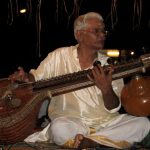VEENA FASHIONISTAS?
We consider ourselves lucky for having got an opportunity, 15 years ago, to settle down in Chennai. Understandably so, since purely from the Carnatic Music performer’s perspective, this has always been the place to be. And, we have come a long way, from those times of fighting our disillusionment on the veena scene in the then Chennai concert circuit, to now, where almost everyday a veena concert is happening somewhere in the city. What we need now is to gather more momentum and keep it going. There should be more people coming to listen to veena concerts not because “they feel the need to do their bit to encourage veena players” but purely because they feel this is what they would like to hear on a particular evening. The onus is very much on us to take it to that level. Aural pleasure is important. In the days of yore, veena was the only instrument known, so it might have enjoyed great monopoly. But now, there are so many more, which with their volume advantage are capable of instantaneously connecting with the average rasika. The veena losing out to the violin as an accompanying instrument is a case in point here. As vainikas, we also have another humungous responsibility….to preserve the gamaka-laden purity of carnatic music for which veena is the singular point of reference, particularly when it comes to Dikshitar Kritis. Over and above is the size of the Saraswathi veena, which itself daunts the organizer (who may be laden with the responsibility of transporting the artist and his/her veena from the airport, etc). He is probably thinking whether getting a van/truck to carry the instrument is worth the effort, or should he settle down to arrange some other concert which requires less paraphernalia. We have heard mridangam vidwans telling us that they have had real tough times lifting huge veena boxes while on overseas trips with lady veena artists!
In the past few years we have found a reasonable solution to these issues. We have been using the electronic veena. We are happy. We have not had to sacrifice the “vadya dharma.” We have not felt the need to play something that we do not want to, just because it “sounds good” and instantly makes the average rasika connect. People in the audience do not have to guess what we are playing. They can hear. The mridangist does not have to tone down his volume to inaudible levels so as not to drown the music of the veena. We can carry/transport our instruments to anywhere in the world without much ado. All this ……. not because it is “modern” or we are some “veena fashionistas”….. but only because we want more people to be able to comfortably hear what is being played, not having the necessity to compromise on what is deemed classical, with the hope that not just “veena rasikas” but “all rasikas” of Carnatic Music can identify with music produced on the veena and connect with it. Clearly, we are using the option because it is available now, and it wasn’t earlier.
Reproduced below is our letter published in The Hindu Friday Review as a rejoinder to a few lines published in a recent review of a young veena artist’s concert. Also is given the link to our interview for Radel’s Newsletter on our thoughts on the electronic veena and other related topics.
THE LETTER
Veena’s tonal quality
This is with reference to the review of Bhavani Prasad’s veena recital (Friday Review, September 4). We refer to a section where the writer has expressed the desire to see the traditional Saraswathi Veena being used increasin gly on the concert stage. The sound produced by a Saraswathi Veena is undoubtedly unparalleled in terms of melody. However, this is true only if the veena is used in its pristine form (i.e. no contact mike). The moment one uses a contact mike, the sound is no longer a result of its resonance from the hollow of the ‘kodam.’ It may be interesting to note that two veenas using the same microphone may produce a sound that may be as different as chalk and cheese. We are yet to see a perfect contact microphone that highlights the right tonal qualities of a Saraswathi Veena, with the exception of perhaps the instrument used by the great Vidwan S. Balachander. To reach out to a large audience, we have turned to the electronic veena as sufficient amplification is possible without much ado; tonal quality can be fine-tuned to suit the artist’s need; in case of a duet, the tonal representation of the two veenas is similar; and, the instrument can be easily transported.
Jaysri and Jeyaraaj




